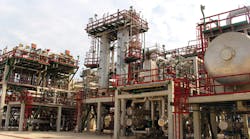Burgeoning supplies of crude oil and liquefied petroleum gas have become the dominant price influences in U.S. LPG markets,
But if the Middle East erupts in war, a revival of supply jitters could reverse fundamentally based price declines, Petral Consulting Co. says in a study of North American LPG markets.
The Houston firm predicts spot prices for West Texas intermediate will remain at more than $30/bbl through January 1991, then decline to $28/bbl in February and $22-23/bbl in April before recovering to $24-25/bbl in May.
Purity ethane prices will decline steadily during first half 1991, reaching 20.3/gal at Mont Belvieu in June, and 15.8/gal at Conway. By June, ethane/propane mix prices at Mont Belvieu will fall to 19.3/gal and to 20.3/gal on the Gulf Coast, Petral says.
Despite higher than normal secondary propane inventories, residual anxiety over supplies will prevent propane prices from declining in step with crude oil and refined products.
Nevertheless, Petral predicts propane prices by next June will range from 24.5/gal on the West Coast to 33/gal in New York Harbor.
Persistent normal butane surpluses and anticipated declines in gasoline production are expected to have a bearish effect on N-butane prices.
By next June, N-butane prices will range from 24.3/gal in Los Angeles to 41/gal in New York Harbor, Petral says.
Isobutane prices this month will range from 70/gal in Los Angeles to 54/gal at Conway, falling by June 1991 to 54/gal and 47/gal, respectively.
Petral predicts natural gas prices will peak in January 1991, ranging from $2.26/Mcf in onshore Louisiana markets to $1.91/Mcf in the Rocky Mountains, where competition is strong from plentiful Canadian supplies.
But mild or late winter weather could undermine gas price increases.
MARKET FUNDAMENTALS
The severity of the effect of bearish fundamentals on crude oil prices is a primary source of uncertainty affecting Petral's price forecasts.
The company says LPG markets are discounting harsh rhetoric "in the face of growing indications that a diplomatic solution may be possible" in the Middle East.
But the presence of more than 1 million troops means that anxiety over the prospect of further supply disruptions "remains a potent, latent bullish influence on prices during the next few months," Petral says.
Prices of competitive ethylene feedstocks have contributed to erosion of ethane values and will increasingly dominate near term propane price trends.
Petral says extraction costs aren't expected to directly influence ethane prices for 3-4 months unless gas processing plant production in the Rocky Mountains falls short of expected recovery in December 1990 and January 1991.
Substantial volumes of propane in secondary and field storage after January will push propane prices to near parity with the least expensive ethylene feedstocks.
Petral expects demand for N-butane as an ethylene feedstock to partially offset bearish influences on N-butane prices of surplus inventories and an anticipated decline in gasoline production.
Refinery demand for isobutane is expected to remain bearish for several months, minimizing price spreads between isobutane and N-butane.
Mont Belvieu isobutane prices through February will average only 2-3/gal above N-butane. By June, the price of isobutane at Mont Belvieu is projected at 46.5/gal, the N-butane price at 38/gal.
By comparison, Petral predicts that in Los Angeles isobutane prices will hold steady during April-June at 54/gal, while N-butane prices will decline to 24.3/gal by June.
Petral estimates that U.S. natural gas inventories are 35% above last winter's levels, so gas marketers and local distribution companies will buy less spot market gas.
Further, Petral says, a decline in gas prices after completion of November contract negotiations shows the presence of surplus supplies. A mild and/or late winter could blunt expected price peaks in December and January by as much as 25-300/Mcf.
Copyright 1990 Oil & Gas Journal. All Rights Reserved.
